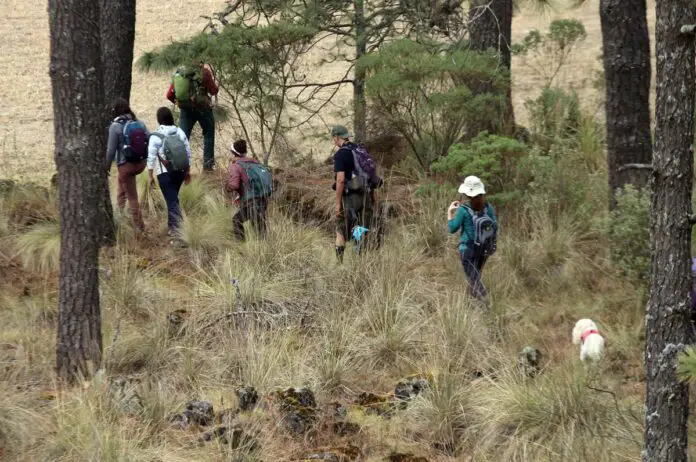Hiking associations denounce the insecurity they suffer in natural environments after the kidnapping of three women who were hiking in the State of Mexico
On November 23, three women were kidnapped while hiking around the Otomí Ceremonial Center, in the municipality of Temoaya, in the State of Mexico. The case was reported in the media because one of the victims was the niece of the former Secretary of Economy Tatiana Clouthier. They managed to free them after a few hours thanks to a police operation, but the reputation of hiking in Mexico had already suffered damage. Can you walk calmly, with friends, in Mexican natural environments? The hiking groups angrily assume the insecurity, the veto of certain places and carrying out this activity with professionals who comply with various protocols.
Jorge Hermosillo has spent more than four decades traveling through the best landscapes in the country. He is coordinator of the Toluca section of the Explorations Club of Mexico, which will turn 102 years old next March. Through the phone he explains that the area where the incident occurred is on yellow alert, the lowest – but already considered unsafe – according to the chromatic range that he uses to measure instability. “In the municipality of Isidro Fabela, the road that goes to the Otomí Ceremonial Center is very lonely and the area is very unprotected,” he explains.
The blame should always lie with the aggressors, the duty to protect with the security forces, but as violence is rampant in Mexico, the Shining Path association has established its own protocol of guarantees. With it they have managed to have few misfortunes happen to them, although Hermosillo remembers an assault against some colleagues on the Haciendas Pulqueras itinerary, which runs through several historic distilleries of the ancient drink in Hidalgo. “It was a bicycle theft, there were weapons, it was about five or six years ago,” he remembers.
So that the horror is not repeated, the club protects itself with a basic but effective object: a whistle. It serves to warn the group of imminent dangers. It is also accompanied by Motorola radios to communicate over long distances. Through the waves, the keys are: yellow, which means attention; orange color, danger; and red, emergency. And several basic questions that must be answered before going on the road: “Where are you going? With who? “What time do you leave and when do you return?”
If you encounter someone suspicious, always greet the guide and “tell a lie” to mislead them. A catalog of measures that must always be kept in mind to be able to enjoy a beautiful walk through a lush forest or a lake in the mountains.
The bad thing is to meet the same person twice. The first is a warning. If the encounter occurs again, it is an orange alert, and the group disperses. “It is a surprise factor to protect us. This happens to us more often, notice,” the hiker denounces.
The sad reality that occurs in the State of Mexico and in other parts surrounding the country’s capital is that some natural areas are off-limits. “We call them red zones,” explains the coordinator. He highlights the insecurity on Mount Tláloc and the top of Tlelapón, two mountains that look beautiful from Mexico City. Or in the beautiful lakes with crystal clear waters surrounded by hills populated by tall pine trees of Zempoala, in Morelos. Natural wonders that have crime as a guardian and keep nature lovers away.
The same problems, with different landscapes, occur beyond the center of the country. In the vast desert plains of Zacatecas, which hides beautiful postcards throughout its territory, the mountain activities group Salvajes de la Pradera has restricted its routes every Thursday to urban or semi-urban areas near the capital of the same name.
-Is it still safe to hike in natural places in Zacatecas?
-I’m honest with you. We prefer to schedule out-of-state trips.
And Eduardo Gil, coordinator of the Zacatecan group, usually goes with crowds of between 100 and 120 people. Strength lies in numbers. The other method of protection is usually to contact the authorities of the place where they are going to do the walk. If he fails to do so, the excursion is cancelled. “We have been aware of other smaller groups that have attacked them,” laments Gil.
Hikers walk near the Nevado de Toluca, on December 23.
He remembers the sound of bullets in Hacienda Nueva, a small town 10 kilometers away from Zacatecas capital, in the municipality of Morelos. “We arrived at the community and a confrontation broke out. We heard the gusts, although luckily we didn’t see it. “We took refuge in a vacant lot, crouching, for about 30 or 40 minutes, until everything happened.” He deeply regrets that criminals are the kings of places to discover. “This year we have been more cautious because we do feel the anxiety of having an encounter with organized crime,” he explains.
In Zapopan, Dínamo Burciaga has been administrator of the Senpertar Hiking Club for four years, which usually tours different parts of Jalisco. Burciaga already knows which parts of the State are prohibited. “One day we went here, near Tequila, to bathe in a pool. Suddenly there was a sign that said private property. Rumors said that there was a marijuana plantation. We don’t look for five legs for the cat,” recalls the guide.
They protect themselves in various ways. “We go to known routes. “A guide in front and another in the back so we don’t get lost and we also share information between hiking groups in case something happens,” he explains. To explore new itineraries he usually sends one or two experienced guides to get to know the place. One of those where crime has not appeared, so we can enjoy nature before climate change takes it away.
Source: El Pais







